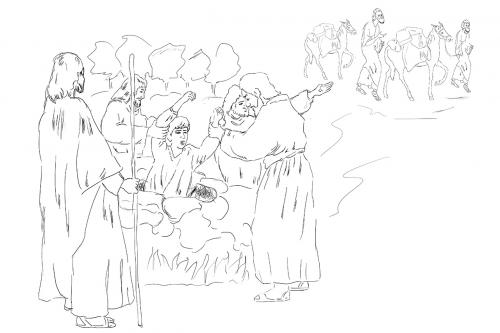



Joseph sold by his brothers
The story of Patriarch Joseph’s youth has often been a source in Christian literature, allegorically foretelling Jesus’ life. Themes such as “The Selling of Joseph into Slavery”, “Joseph and Potiphar’s Wife”, or “Potiphar’s Wife Falsely Accusing Joseph” were seen as parallels to “Judah’s Treason”, “The Temptation of Christ” and “Jesus’ Process”. Although these are Old Testament references frequently employed, the scenes from Joseph’s life have been less evoked in Byzantine and Post-Byzantine art, compared to the notoriety they enjoyed in Western art since Early Christianity. That is why there are no explicit canons for such iconographical representations.
Usually, the number of characters present into the scene of “Selling Joseph into Slavery” is minimal. There is young Joseph thrown into a hole or cistern, where he is sunk up to his waist, some of his brothers are holding him, while the Medianite merchants’ caravan is depicted more or less elaborately. There are cases in which a special attention is paid to Judah, who is identified, according to the Biblical text, as the brother who proposed to the others the Selling of Joseph instead of his killing.
The story of Patriarch Joseph’s youth has often been a source in Christian literature, allegorically foretelling Jesus’ life. Themes such as “The Selling of Joseph into Slavery”, “Joseph and Potiphar’s Wife”, or “Potiphar’s Wife Falsely Accusing Joseph” were seen as parallels to “Judah’s Treason”, “The Temptation of Christ” and “Jesus’ Process”. Although these are Old Testament references frequently employed, the scenes from Joseph’s life have been less evoked in Byzantine and Post-Byzantine art, compared to the notoriety they enjoyed in Western art since Early Christianity. That is why there are no explicit canons for such iconographical representations.
Usually, the number of characters present into the scene of “Selling Joseph into Slavery” is minimal. There is young Joseph thrown into a hole or cistern, where he is sunk up to his waist, some of his brothers are holding him, while the Medianite merchants’ caravan is depicted more or less elaborately. There are cases in which a special attention is paid to Judah, who is identified, according to the Biblical text, as the brother who proposed to the others the Selling of Joseph instead of his killing.




